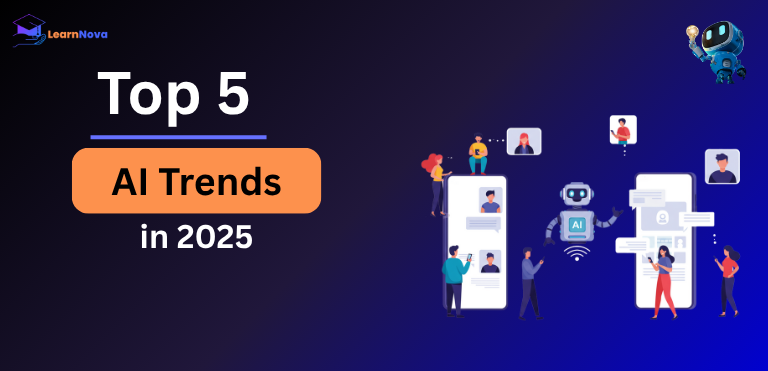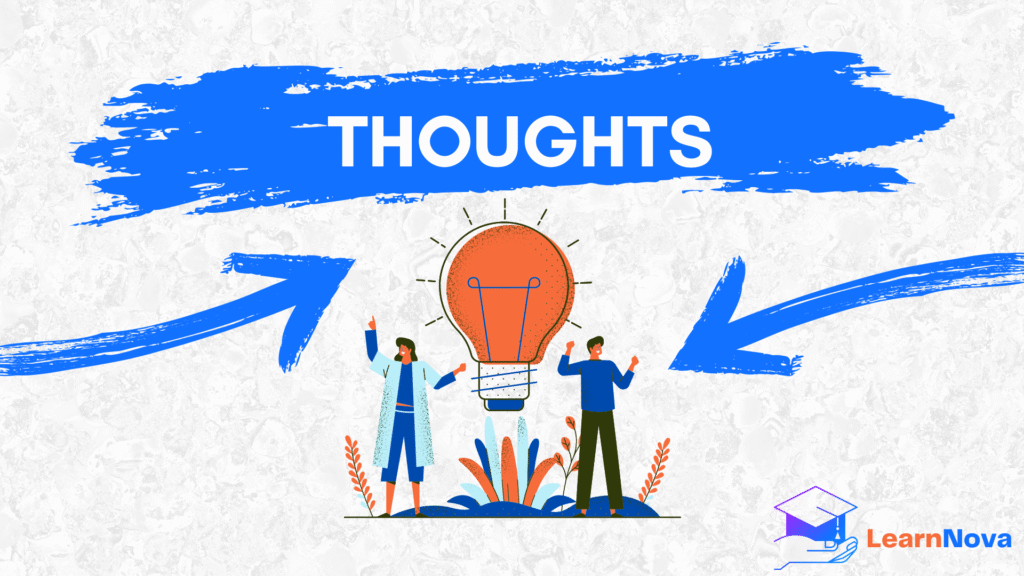Top 5 AI Trends in 2025 You Can’t Afford to Miss

Table of Contents
Introduction
Artificial Intelligence is rapidly transforming every industry — from healthcare and education to marketing and manufacturing. As we progress through 2025, it’s clear that AI is not just a trend — it’s the future. But what specific developments are leading the charge?
In this post, we’ll explore the Top 5 AI trends in 2025, backed by insights from Google trends, expert blogs like OpenAI, Google AI, and 365 Data Science, and real-world use cases.
1. Generative AI: The Creative Powerhouse of the Future
Generative AI refers to machine learning models that can create new content by learning from large datasets. This includes generating text, code, images, audio, videos, and even 3D models..
What’s New in 2025:
Tools like GPT-4o, Gemini, Sora, and Claude now support multimodal generation, meaning they can work with multiple types of input/output (text + image + voice).
Businesses use it to generate marketing copy, websites, reports, and more with just a prompt.
Real-World Use Cases:
- Startups use generative AI to build MVPs (Minimum Viable Products) in days.
- Educators create entire lesson plans with interactive media using AI.
- Artists and designers generate concepts and mockups with tools like Midjourney or Adobe Firefly.
Key Tools:
- ChatGPT / GPT-4o
- Google Gemini
- DALL·E 3
- Sora (for video generation)
- GitHub Copilot (for code generation)
Read More (Click Here): The Rise of Generative AI in 2025
2. AI Agents: Intelligent, Autonomous Virtual Workers
AI agents are autonomous systems that can reason, plan, execute tasks, and even coordinate with other agents. Unlike basic chatbots, these agents can operate over long tasks without needing repeated human input..
What’s New in 2025:
Devin by Cognition Labs: an AI software engineer that can read tickets, write code, and fix bugs.
AutoGPT & BabyAGI: frameworks that allow AI agents to operate based on goals, not just commands.
Real-World Use Cases:
- Startups use agents to handle customer service, schedule meetings, and conduct market research.
- Software teams deploy agents to do integration testing and deployment automatically.
- Researchers use AI agents to analyze massive datasets and find insights.
Key Tools:
- Devin AI Engineer
- AutoGPT
- MetaGPT
- CrewAI (multi-agent systems)
3. Multimodal AI: Human-Like Understanding Across Formats
Multimodal AI refers to AI systems that can process and combine different types of data — such as text, images, video, audio, and code — to better understand context and produce richer responses..
What’s New in 2025:
GPT-4o can see images, listen to audio, read expressions, and talk — all in real time.
Google Gemini allows users to upload PDFs, diagrams, and videos and ask questions about them.
Meta’s LLaVA can look at a photo and describe its contents accurately.
Real-World Use Cases:
- Doctors use multimodal AI to analyze X-rays + written symptoms for faster diagnosis.
- Teachers use AI that listens to student questions, watches their whiteboard notes, and responds verbally.
- Customer service bots can see what the user uploaded (e.g., error screenshots) and walk them through solutions.
Key Tools:
- OpenAI GPT-4o
- Google Gemini 1.5
- Meta LLaVA
- Perplexity with Vision
4. Federated Learning & Private AI: Data Privacy at the Core
Federated learning is a method where AI models train locally on devices (e.g., smartphones) rather than collecting user data on a central server. It allows model training without compromising data privacy.
What’s New in 2025:
Apple and Google use federated learning in iPhones and Android to improve predictive text, without reading your messages.
Hospitals and banks use secure, decentralized models to train AI with sensitive data.
Real-World Use Cases:
- Health apps use on-device learning to improve personalized diet/exercise recommendations.
- Finance apps detect fraud trends across devices without sharing transaction details.
- Smart keyboards (like Gboard) improve word prediction without storing personal chats.
Key Tools:
- TensorFlow Federated
- PySyft
- Flower
- Apple’s Core ML + Secure Enclave
5. AutoML & Synthetic Data: AI That Builds AI
AutoML (Automated Machine Learning) is the use of AI to automate the design and training of other machine learning models.
Synthetic data is computer-generated data that mimics real-world patterns and is used for training models where data is limited or sensitive.
What’s New in 2025:
Anyone can now build and deploy an ML model with no coding, thanks to AutoML platforms.
Synthetic data is used heavily in healthcare, retail, and cybersecurity to reduce risks of bias, legal issues, and data scarcity.
Real-World Use Cases:
- E-commerce companies use synthetic customer journeys to train recommendation engines.
- Autonomous car companies simulate millions of hours of driving scenarios using synthetic data.
- Startups use AutoML to prototype and deploy models without hiring large data science teams.
Key Tools:
- Google Cloud AutoML
- Amazon SageMaker
- Hazy (synthetic data)
- Mostly AI
- Microsoft Azure AutoML
Conclusion
In 2025, AI is transforming from a support tool into a powerful partner across every industry — enabling automation, creativity, and smarter decision-making. Understanding key trends like generative AI, intelligent agents, multimodal systems, federated learning, and AutoML is essential for staying ahead. Whether you’re a developer, entrepreneur, or learner, embracing these innovations will not only future-proof your skills but also open doors to faster, more efficient, and more impactful work.

